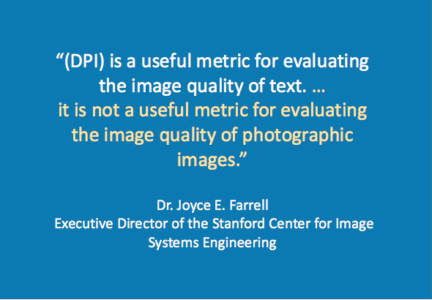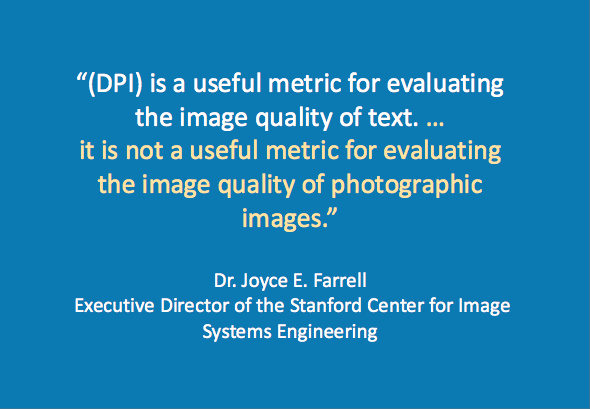The redoubtable Marco Boer of I.T. Strategies posed this skeptical question about apparent resolution in a video here last fall, while mocking the tendency of some inkjet printer vendors to hype their specifications. I covered some of the same ground in a 2013 article in the SGIA Journal and, while I share Marco’s cynicism about specmanship, I thought it might be helpful to examine the grain of truth that lies behind the weaselly words “apparent resolution”.
Let me try to explain why manufacturers introduced the term, and what justifies a particular value. The answer to the ‘why’ question is straightforward: marketing people think that potential buyers are naïve – they think the quality of a printer is higher if it claims a higher resolution, as signified by a DPI (dots per inch) value. Well, perhaps they don’t actually believe this, but they want to keep their quality claim as simple (or simplistic) as possible. What was it Einstein said? “Make things as simple as possible, but no simpler.” As the sophisticated readers of Inkjet Insight know, print quality depends on much more than resolution, and resolution is anyway not to be confused with addressability.
So the person writing marketing collateral for a printer with 360 dpi resolution has to find a way to avoid having it appear to be only 36% as good as a competitor with a 1,000 dpi printer. And they want to do this without having to explain the effects of different drop sizes, dot gain on different paper stocks, or drop placement accuracy – this is too complicated. But if the 1,000 dpi printer has only a single drop size and the 360 dpi printer uses “grayscale” or variable drop sizes, the term “apparent resolution” gives a simple metric that captures some important research about the perceived quality of photographic images reproduced at different resolutions and grayscales.
Dr. Joyce E. Farrell, of formerly of HP Labs and now Stanford University, has written extensively for over 3 decades on this topic. In a 1997 paper, she concluded that: “(DPI) is a useful metric for evaluating the image quality of text. However, it is not a useful metric for evaluating the image quality of photographic images. Consumers would be better advised to inquire about the bits of grayscale/dot (bpd) when considering purchasing a printer optimized for photographic image quality.” In this paper and elsewhere, she explores the trade-off between resolution and greyscale bits/pixel, but concludes that there is no simple formula, and that judging equivalent quality is quite image-specific.
 This means that “apparent resolution” is necessarily a vague and unscientific concept. But here is a partial justification, using traditional half-toning as the basis for the explanation:
This means that “apparent resolution” is necessarily a vague and unscientific concept. But here is a partial justification, using traditional half-toning as the basis for the explanation:
Recall that in traditional offset litho printing, ‘AM screening’ is used in creating half-tones to reproduce photographic images. That is, variably-sized dots are produced by a high-resolution imagesetter (capable of creating laser dots at 2,450dpi, for example). A square dot might be made up by filling in from 1-100 pixels in a 10×10 pixel matrix, with each dot lying on a fixed-resolution grid of 245 lines/inch – the ‘screen ruling’. The screen dots are ‘amplitude modulated’ by the changing photographic image density, but their relative positions are fixed by the grid. The pitch or screen ruling is 245 lpi, but the individual dot sizes vary from 1% (highlight) to 100% (shadow). A more recent printing development was ‘FM’ (or ‘stochastic’) screening, in which the variations in image density are reproduced by varying the distance between the dots – the frequency – rather than the dot size, which is kept fixed. The printer is effectively printing a collection of highlight dots, bunched closely together in the shadow areas of the image, and spread out in the lighter areas.
This is how binary inkjet printing works too – the inkjet printer varies the positions of dots of fixed size to match the varying density of a photographic image, usually using an ‘error diffusion’ algorithm to place the dots. The dots on the paper are made by ink drops of a fixed size.
Grayscale inkjet printing is like a combination of AM and FM screening – the dot size can be varied, by changing the drop volume, AND the relative positions of the dots is varied by the error diffusion algorithm. So now we can draw an analogy between traditional half-toning and inkjet: whereas a traditional (AM screened) image might use a 10×10 matrix of pixels to create screen dots of up to 100 grey levels (0-100% density), an inkjet RIP driving a printhead with, say, 9 grey levels can be thought of as using a matrix of 3×3 pixels for each dot, placed on a grid with dimensions equal to its advertised resolution. Hence the claim that the inkjet printer’s “apparent” or “effective” resolution is equal to the nozzle density multiplied by the square root of the number of gray levels. So our 360 dpi, 9 gray level print engine can be said to have an “apparent resolution” of 3 x 360dpi = 1,080dpi, effectively matching the single-drop-sized 1,000 dpi printer. The marketing person working for the grayscale printer manufacturer has a simple metric that matches the competition’s resolution claim, and she can justify it by citing Farrell and others, whose research shows that images reproduced by grayscale printers look better than images of the same resolution from binary printers.
But, there are a couple of important caveats – the first is the point already made: “apparent resolution” is subjective and unscientific, even though the analogy I just described gives it a fig leaf of theoretical justification. The second is more important – the concept of equivalent resolution applies only to continuous tone images. Although grayscale printing can reduce the staircasing (aka “aliasing”) visible in low-resolution line-art and text by filling in the stair-steps with smaller drops, the print quality cannot match a higher-resolution printer. The “apparent resolution” of the 360 dpi grayscale printer might give comparable results to the 1,000 dpi printer on photographs, but it will not match it on 4-point type.
So the answer to the question “What does ‘apparent resolution’ even mean”? I hope I’ve shown that it means something – but it doesn’t mean enough to base a purchase decision on.
Acknowledgement: my thanks to Julian Bane, who explained inkjet half-toning when we were colleagues at Xaar plc a dozen years ago, giving me this rare opportunity to tell Marco Boer something about inkjet that perhaps even he didn’t already know!
Editor’s Note:
 Chris Lynn is the principal partner with Hillam Technology Partners, LLC, a company providing marketing & sales process improvement services to international technology businesses. He is a frequent speaker at inkjet conferences, author of several articles on digital printing technology and co-author of the 2010 ‘Industrial Inkjet for Dummies’.
Chris Lynn is the principal partner with Hillam Technology Partners, LLC, a company providing marketing & sales process improvement services to international technology businesses. He is a frequent speaker at inkjet conferences, author of several articles on digital printing technology and co-author of the 2010 ‘Industrial Inkjet for Dummies’.
Clearly he can also write for non-dummies and we are very happy to have him as a contributor at Inkjet Insight.
If you enjoyed this post from Chris, you may also enjoy his previous article, “Action at a Distance, Inkjet’s Original Sin.”
Please register for a free membership to continue to receive access to in-depth inkjet discussions and tools you won’t find anywhere else.

